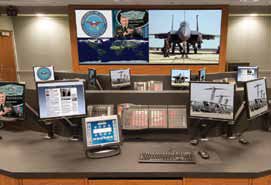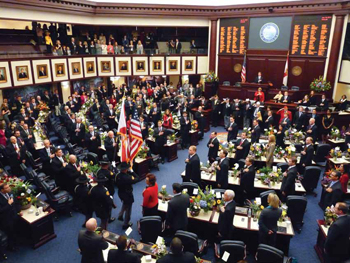At the Florida House of Representatives, Tallahassee, FL, a MediaMatrix NION audio system helps the on-site techs manage the session’s schedule through a touchscreen interface developed in NWare Kiosk software.When the economy began spiraling downward in 2008, the public sector remained a promising prospect—the government was the one client that was still spending money. For many systems contractors, this proved a stabilizing force, enabling them to make up for lost revenues by serving municipal, state, and federal agencies.
But where do government contracts stand now? Well, it depends on what segment of government you’re talking about… and whom you ask.
Public works projects, for example, have tailed off, according to Chuck Wilson, executive director of NSCA. “Most of the money has run out from when the stimulus package was initiated a couple of years ago,” he said. “It has either been spent or repurposed.”
Based on input from his organization’s members, Wilson noted that the same goes for courthouses. “Those things have been set on the back burner for now, until the shape of which political slant our three branches of the government take on. Or two, anyway. Depending on how Congress looks, depending on how the White House looks, I think everything is kind of set aside for right now.”
This isn’t exactly the case for those companies working with the Department of Defense (DOD) or the Department of Homeland Security, however. “I think that ever since 9/11, for better or for worse, Homeland Security and defense spending has gone up,” said Paul Corraine, founder and principal at Convergent Technologies Design Group, a consulting firm based in Baltimore, MD. “We have been working on projects with the military that we, maybe, wouldn’t have normally seen.” As of press time, Convergent Technologies was working on a project at the U.S. Department of State.
Barry Goldin, vice president of business development at Audio Video Systems in Chantilly, VA, noted that the majority of his company’s government work lies in intelligence and the DOD. As such, he has also not witnessed a significant decrease in government spending. “A lot of the federal government spending in technology has been stable, or increasing. Various efforts to get improved operations and improved performance have driven infrastructure improvements and technology integration.” He conceded, however, that it is often common to see spending slowdowns during election years. “It’s a pretty well-understood process where people tend to want to slow down and see what the new administration, or new leadership, might want.”


Audio Video Systems, which does the majority of its government work in intelligence and the DOD in projects
including the MARFLPAC Command Operations Center (top) and Pentagon Watch Floor (bottom), has not witnessed a
significant decrease in government spending.For Wilson, one area of opportunity continues to be in the design and integration of mass notification emergency communication (MNEC) systems. “Those systems were mandated, so there is quite a process under way to make sure that every government facility in the U.S. has some form of evacuation system, or way of letting people know that there is a threat, or some sort of incident that’s occurred, or anything like that,” he said. Network operations centers or command and control facilities also continue to grow, he added, as cities seek ways of doing a better job at employing surveillance across wider areas, so they may efficiently respond to natural disasters, shootings, or terrorist events.
Interactivity is also something government agencies are seeking, Corraine pointed out. “If I had to choose one word to describe it, it would be ‘interactive,’” he said. “Whether it’s the kiosks and virtual tables that we are planning for the State Department project, or the videoconferencing that we are doing for a DOD facility, interactive technologies are being asked to be specified on government projects.” 3D, he added, is also becoming popular for training purposes.
Goldin noted that an increasingly competitive marketplace has resulted in price pressure; value has become a harder sell. “That is driven by a realization of the strength of the market—there are a lot of new entrants— as well as some cyclical up and down in the spending cycles,” he explained. Procurement has become more about price across all government spending, he said—not just AV. There is much more emphasis on lowest cost, technically acceptable, rather than best value. That introduces some challenges for those of us that work in this marketplace. You really have to be really business development oriented, and less RFP response/sales oriented. That’s really the only way to succeed in those endeavors.”
Carolyn Heinze is a freelance writer/editor.
Contract Conscious
While the government may prove to be a great client, it doesn’t operate like a private company, necessitating a level of due diligence that some systems contracting firms may not be accustomed to. This is especially true when it comes to contracts, underlined Chuck Wilson, executive director of the NSCA.
“Always remember when you are working on a government project that the level of sophistication in the contract administration portion of your project has to go up by about 10-fold,” he said. “The risk proposition goes up dramatically on a government facility.”
What makes this tricky is that in many government projects, systems integrators may be working off of a purchase order from another contractor, and they may not have been privy to all of the requirements that every contractor in the project is required to adhere to. Liquidated damages are one common risk exposure for contractors who, in most cases, are performing their work at the end of construction. “If they are the ones that held up that project, generally in the specifications, someone is responsible for so many thousands of dollars a day penalty for not turning the job over to the owner on time. Our members get tied into this quite often because they just don’t have a realistic timeframe in which to do their work.” However, if contractors are aware of this clause beforehand, they can start communicating with the powers that be to work out a less costly arrangement. “Generally, they can buy themselves more time.”
—C.H.
Assistive Listening in Courtrooms
With translation systems becoming mandatory in many court systems, and compliance with the Americans with Disabilities Act (ADA) requirements for hearing assistance a given, it’s increasingly likely that your next government contract will involve an assistive listening solution. What factors should you consider when selecting and installing such technology?
The first decision to make is whether to go with an infrared (IR), FM, or induction loop system. “IR is used widely and is wonderfully controlled to the room it is in,” explained Steve Wooley, wireless listening product group leader at Listen Technologies. Due to IR’s more secure nature, it is the best option when confidentiality is a priority, and for sensitive translation applications. “FM works and is well understood to be a good value,” Wooley continued, “but security is a big problem due to leakage through walls.”
Listen loops in courtrooms are much loved by t-coil installed hearing aid users, which, at close to 90 percent of hearing aids being sold, is a hot and rapidly growing installed base, said Wooley. “Loop carries a higher initial cost for installation, but gives exceptional performance and utility to wearers, with no real additional cost of operation once installed. It provides ‘prescription’ sound directly to the wearer—the audiologist prescribed EQ and level correction is fed by the hearing aid receiving the induction loop signal, as opposed to the hearing aid mic’s picking up and amplifying the whole courtroom noise environment. Again, the user does not need to chase down and ask for an assistive listening device, headset, earbuds, earspeakers, etc., and trust they are clean and charged and even working! And to the same degree, the court doesn’t have to hire, train, and maintain someone to provide these support devices.”
According to Wooley, loop systems installed to and compliant with IEC60118-4 are a revelation for most the first time they encounter a properly operating system. They hear the judge, the lawyers, the events of the court as a direct feed from the sound system, with no courtroom background and interfering noise.
In conclusion, he strongly advised that any decisions being made objectively take all these factors into account as well as in-use cost over the long term.
—Chuck Ansbacher










